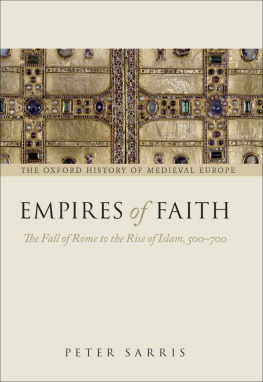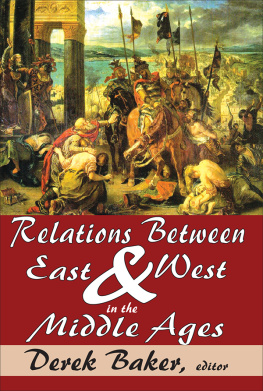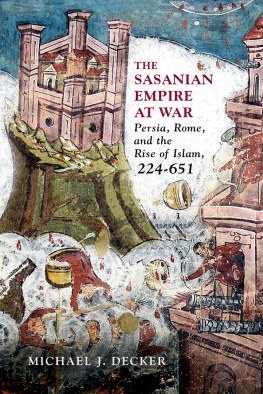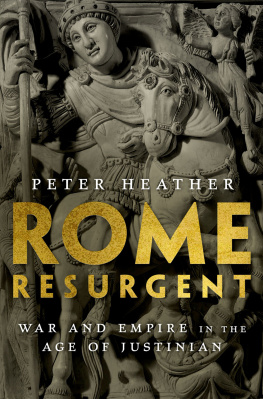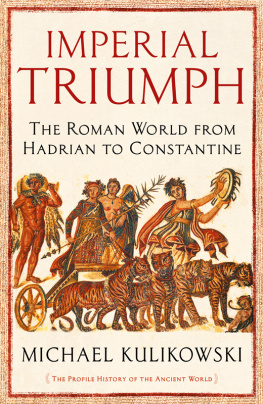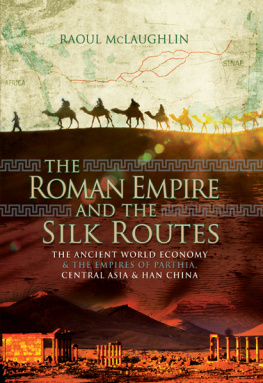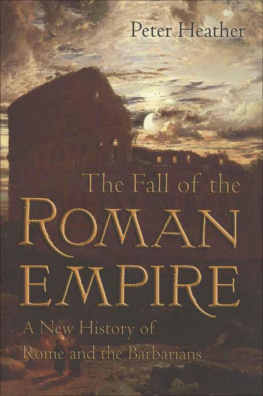THE OXFORD HISTORY OF MEDIEVAL EUROPE
General Editors
JINTY NELSON and HENRIETTA LEYSER
Empires of Faith
The Fall of Rome to the
Rise of Islam, 500700
PETER SARRIS


Great Clarendon Street, Oxford OX2 6DP
Oxford University Press is a department of the University of Oxford.
It furthers the Universitys objective of excellence in research, scholarship,
and education by publishing worldwide in
Oxford New York
Auckland Cape Town Dar es Salaam Hong Kong Karachi
Kuala Lumpur Madrid Melbourne Mexico City Nairobi
New Delhi Shanghai Taipei Toronto
With offices in
Argentina Austria Brazil Chile Czech Republic France Greece
Guatemala Hungary Italy Japan Poland Portugal Singapore
South Korea Switzerland Thailand Turkey Ukraine Vietnam
Oxford is a registered trade mark of Oxford University Press
in the UK and in certain other countries
Published in the United States
by Oxford University Press Inc., New York
Peter Sarris 2011
The moral rights of the author have been asserted
Database right Oxford University Press (maker)
First published 2011
All rights reserved. No part of this publication may be reproduced,
stored in a retrieval system, or transmitted, in any form or by any means,
without the prior permission in writing of Oxford University Press,
or as expressly permitted by law, or under terms agreed with the appropriate
reprographics rights organization. Enquiries concerning reproduction
outside the scope of the above should be sent to the Rights Department,
Oxford University Press, at the address above
You must not circulate this book in any other binding or cover
and you must impose the same condition on any acquirer
British Library Cataloguing in Publication Data
Data available
Library of Congress Cataloging in Publication Data
Data available
Typeset by SPI Publisher Services, Pondicherry, India
Printed in Great Britain
on acid-free paper by
MPG Books Group, Bodmin and Kings Lynn
ISBN 978-0-19-926126-0
1 3 5 7 9 10 8 6 4 2
General Editors Preface
The only traditional thing about this series is that its volumes will form a chronological sequence. Each volume will be single-authored and cover one or two centuries. Beyond coverage of the medieval time-span, the editors have shied away from insisting on uniformity of presentation, which can have a stultifying effect and lead to dissimilar periods finding themselves shoe-horned into common patterns. Instead, authors are encouraged, within whatever geographical frame they choose for their volume (and those will vary), to treat Europe as broadly as possible, to break away from narrowly Eurocentric perspectives, and to range, as and when desirable, beyond Europe (e.g. to the Near East or North Africa). Each author will be free to emphasise, and connect, themes that they consider significant, in light of their own work and of contemporary trends in historiography. While we expect a concern with beliefs and ideas, values and sentiments to reflect historys cultural turn, authors will offer individual interpretations of their chosen periods, reflecting as they consider appropriate on interdisciplinary approaches, especially via consideration of material culture. The editors intention is that each authors distinctive voice should be heard loud and clear, and we expect each volume to have its own unity and pace.
Our authors have been liberated from the need to produce a standard authoritative accountalways a rather chimerical conceptand we trust them to write with the energy and bravado such freedom unleashes. Every historian reflects the concerns of their own times: our series will be different only in so far as this will be an explicit aim. The editors will encourage authors to address twenty-first-century controversies when they think that their work offers useful connexions, comparisons and points of departurefor in this way the volumes will, we hope, contribute to better understandings of our own contemporary world.
Jinty Nelson and Henrietta Leyser
To my mother
Patricia Sarris
for her many years of love, labour, and support
Contents
List of Maps
. The Growth of Roman Rule (J. Boardman, J. Griffin, and O. Murray, The Oxford History of the Classical World, pp. 5345)
. The Roman Empire c.AD 390 (C. Mango, The Oxford History of Byzantium, p. 33)
. Europe c. 526 (R. McKitterick, The Short Oxford History of Europe: The Early Middle Ages, pp. 28081)
. The War Zone between Byzantium and Persia (C. Mango, The Oxford History of Byzantium, p. 41)
. Justinians Empire in 565 (C. Mango, The Oxford History of Byzantium, p. 52)
. Pre-Islamic Arabia (C. Mango, The Oxford History of Byzantium, p. 120)
. Theme Commands in Byzantine Asia Minor c.720 (J. D. Howard-Johnston, Witnesses to a World Crisis, p. xxxii)
. Europe c.732 (R. McKitterick, The Short Oxford History of Europe: The Early Middle Ages, pp. 2823)
List of Figures
. Execution of Barbarians on the Column of Marcus Aurelius (B. Ward-Perkins, The Fall of Rome and the End of Civilization, Oxford 2005, p. 26)
. Ivory Diptych of Stilicho and Family (C. Mango, The Oxford History of Byzantium, p. 37)
. The Theodosian Land Walls (C. Mango, The Oxford History of Byzantium, p. 67)
. Reconstruction of Seal-Ring of Childeric (reproduced by kind permission of the Ashmolean Museum, Oxford, and the Bridgeman Art Library)
. Gold Medallion with Bust of Theoderic (B. Ward-Perkins, The Fall of Rome and the End of Civilization, Oxford 2005, p. 73)
. Mosaic Panel Depicting Justinian, San Vitale, Ravenna (C. Mango, The Oxford History of Byzantium, p. 60)
. Exterior of Hagia Sophia, Constantinople (C. Mango, The Oxford History of Byzantium, p. 47)
. St Albans Cathedral and Shrine Viewed through the Walls of Verulamium (photograph reproduced by kind permission of James Cridland, esq.)
. Silver Hexagram of Heraclius and Heraclius Constantine (by kind permission of the Fitzwilliam Museum, Cambridge)
. Arab Mock-Byzantine Solidus (C. Mango, The Oxford History of Byzantium, p. 127)
. Standing Caliph Solidus (C. Mango, The Oxford History of Byzantium, p. 127)
. Solidus of Justinian II (by kind permission of the Fitzwilliam Museum, Cambridge)
. Helmet from Sutton Hoo (by kind permission of the British Museum, London)
. The Staffordshire Hoard (by kind permission of the Birmingham Museum and Art Gallery)
. Anglo-Saxon sceatta bearing image of Christ (by kind permission of Lord Stewartby and the Royal Numismatic Society)
Introduction and Acknowledgements
The starting and finishing dates for this volume, c. AD 500 and 700, are not in themselves significant. No major cataclysm, crisis, or foundation event detailed in this work occurred in either 500 or 700; neither do these dates constitute obvious book ends to a specific era, movement, or regime. However, it is my contention, in the pages that follow, that the period from the late fifth to the early eighth century witnessed a series of crucial developments that were to do much to define the medieval world as commonly understood: in the west, these centuries saw the demise of the power of the Roman state and the emergence to the fore of social relations of a martial elite and a culture of military lordship; to the east, the period witnessed the economic, cultural, and administrative recasting of the surviving Eastern Roman Empire and its transformation into the society known to us as Byzantium; whilst across the eastern and southern shores of the Mediterranean (and beyond) these years were associated with the formation and ascendancy of a sophisticated Islamic rival and foe, whose presence would do much to give sharper definition to an embryonic Christendom.
Next page
